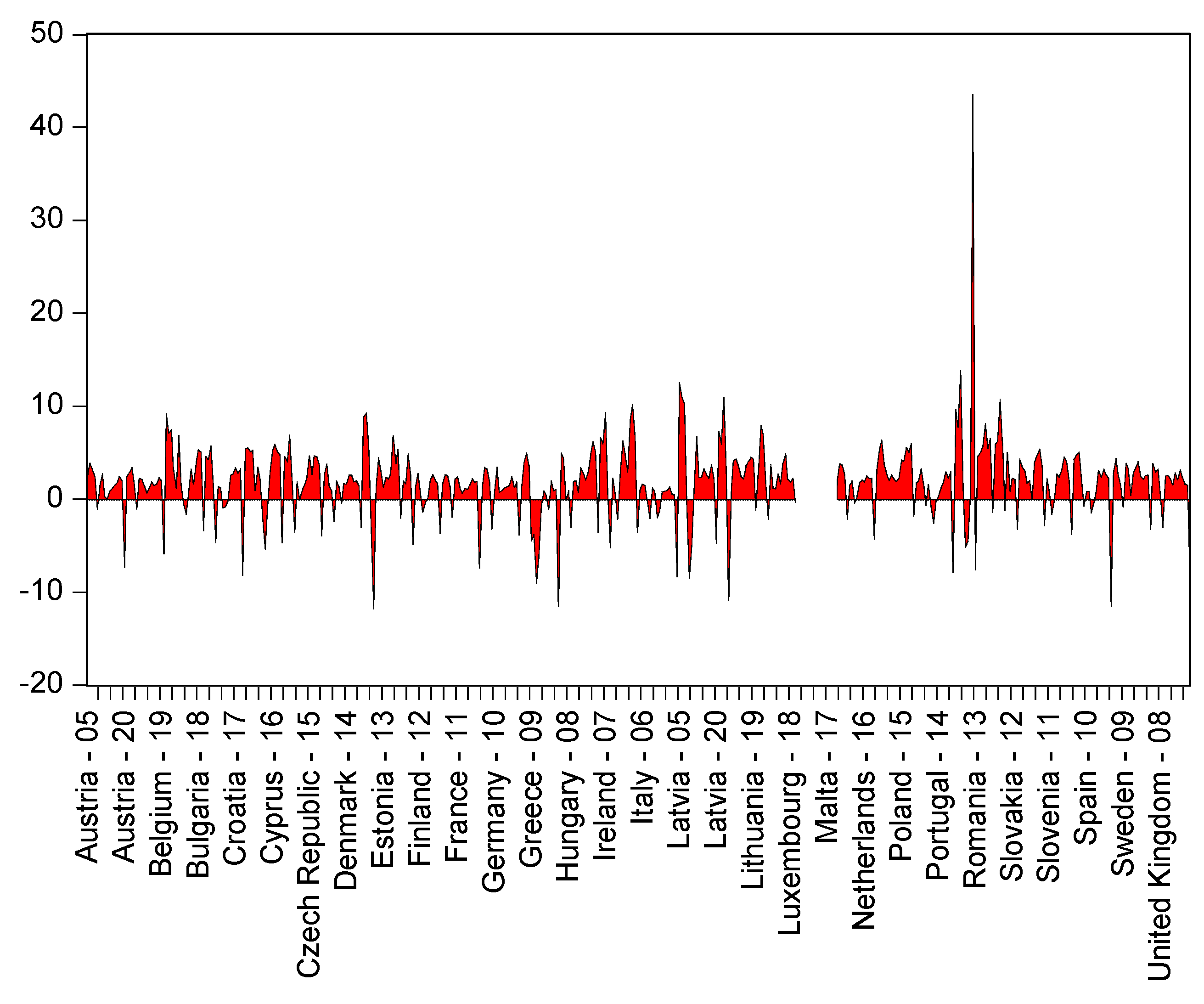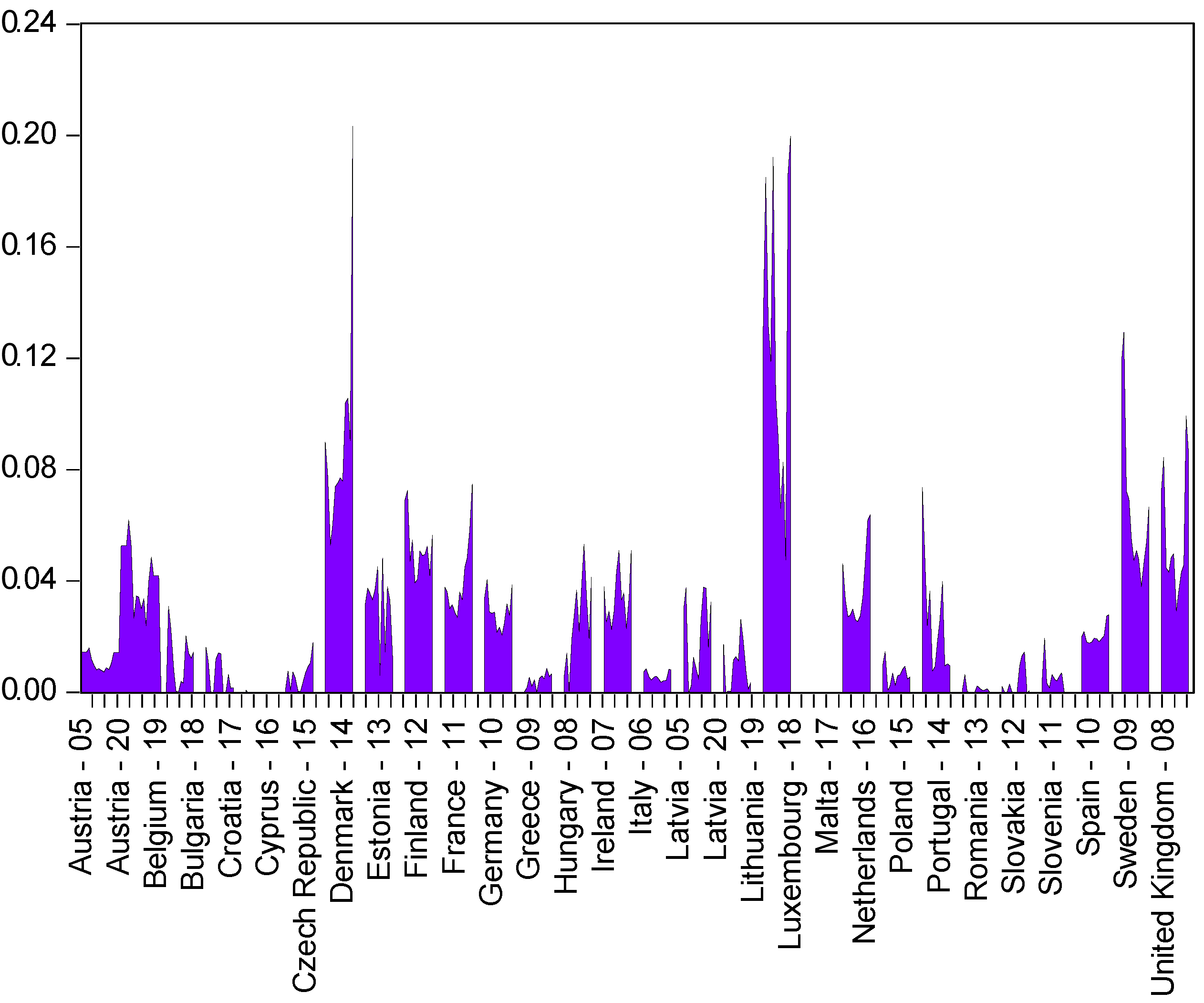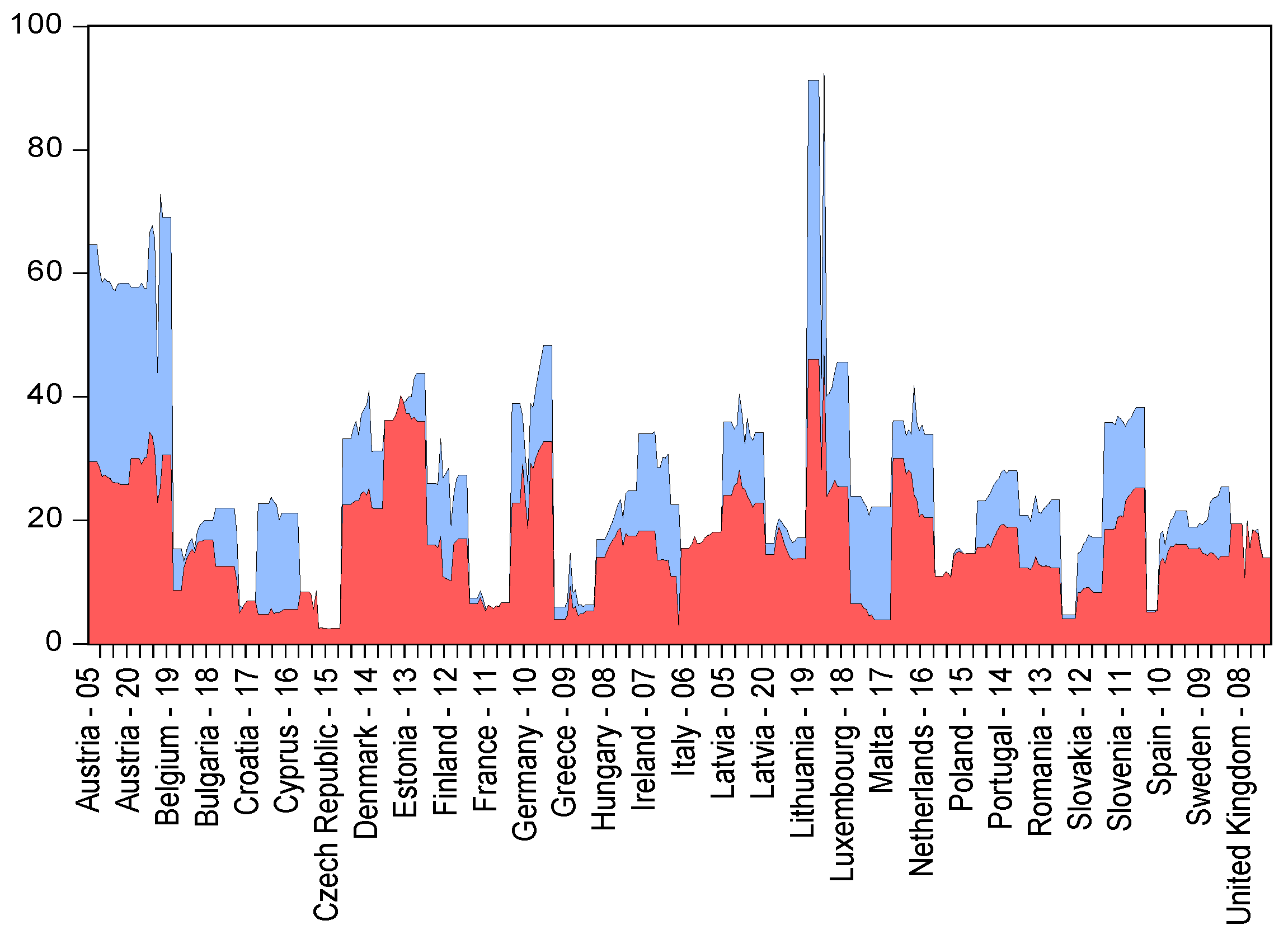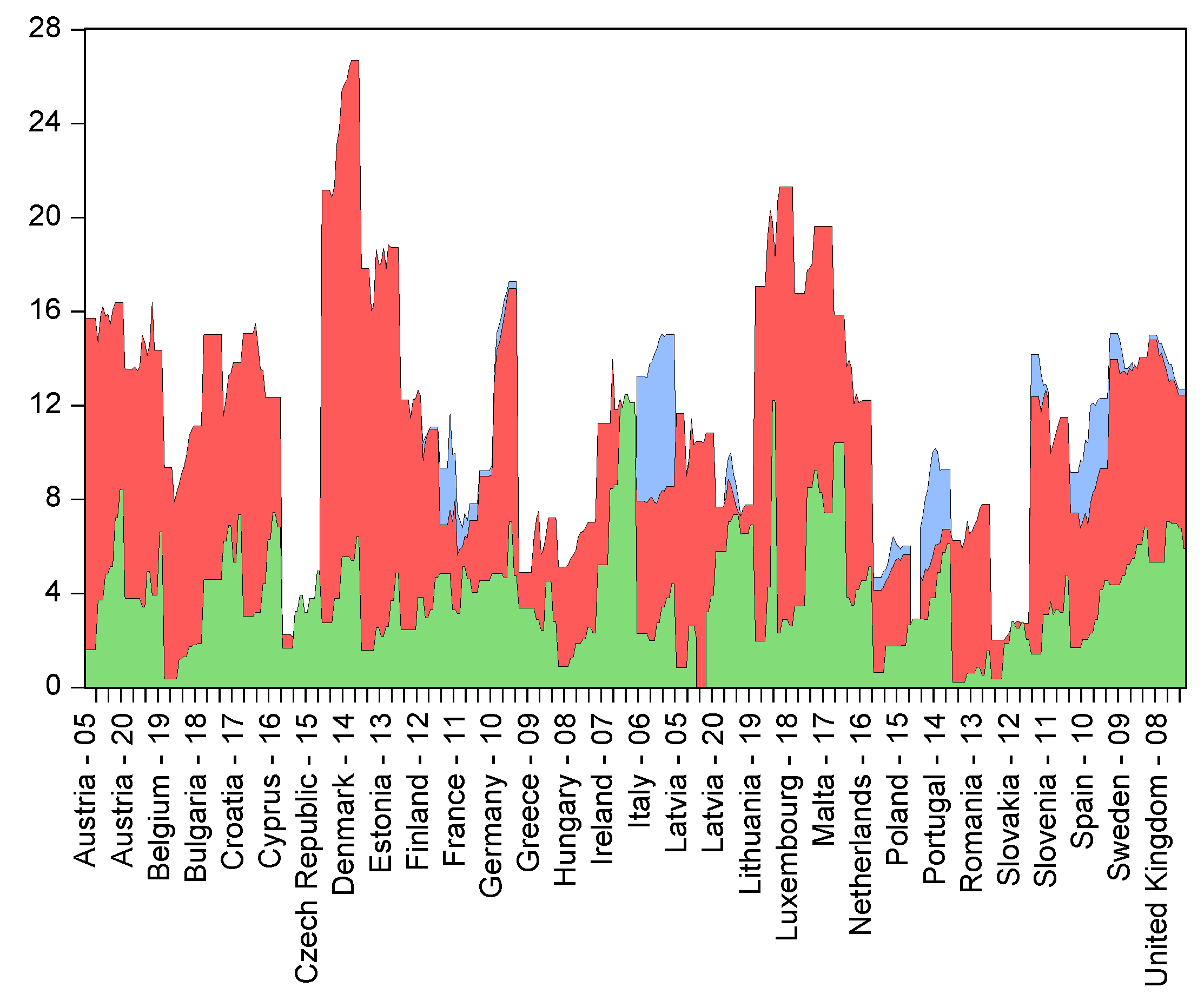Determinants of Economic Growth across the European Union: A Panel Data Analysis on Small and Medium Enterprises
Abstract
:1. Introduction
2. Literature Review
3. Materials and Method
- Value added rate (VAD_RATE) measures the variation of the value added of goods and services produced in a national economy. This variable was used as a proxy for the level of economic growth, it is measured in percentage points and it was retrieved from the World Bank database.
- Venture capital investments rate (VENTURE) as a percentage of GDP represents a part of private equity that needs to be invested in companies not publicly listed, which develop new products and technologies. This type of investment is used to support early-stage business endeavors (i.e., seed, start-up) or expansions (i.e., “later stage venture”). The variable was retrieved from the Eurostat database and it was used as a proxy for the level of economic growth.
- Turnover from e-commerce rate (TURNOVER) includes the overall turnover from all manufacturing and service sectors, excluding the financial sector. The variable was retrieved from the Eurostat database, namely the Community survey on ICT usage and eCommerce in enterprises. It was used as a proxy for the level of economic growth.
- Intra-EU exports of goods by SMEs in industry (EUEXP) measures the percentage of SMEs that exported goods within the EU member states. The variable was retrieved from the Eurostat database.
- Intra-EU imports of goods by SMEs in industry (EUIMP) measures the percentage of SMEs that imported goods from the EU member states. The variable was retrieved from the Eurostat database.
- Intra-EU online importers (EUIMPOL) measures the percentage of SMEs that imported goods online from the EU member states. This variable took into consideration only SMEs with 10 or more employees, which made online acquisitions from suppliers operating in other EU countries. Micro-companies were not considered. The variable was retrieved from the Eurostat database.
- Extra-EU online exporters (EUEXTRAOL) measures the percentage of SMEs that exported goods online in other EU member states. This variable took into consideration only SMEs with 10 or more employees, which made online acquisitions from suppliers operating in other EU countries. Micro-companies were not considered. The variable was retrieved from the Eurostat database.
- Extra-EU exports of goods by SMEs in industry (EXTRAEXP) indicates the percentage of SMEs that exported goods outside the European Union. This time, micro-companies were included. In order to compute the variable, the number of exporting SMEs (in the nominator) was retrieved from the Comext database, while the total number of SMEs (in the denominator) was retrieved from the Structural Business Statistics database.
- Extra-EU imports of goods by SMEs in industry (EXTRAIMP) measures the percentage of SMEs that imported goods from countries outside the European Union. As before, micro-companies were included. In order to compute the variable, the number of exporting SMEs (in the nominator) was retrieved from the Comext database, while the total number of SMEs (in the denominator) was retrieved from the Structural Business Statistics database.
- represents the intercept;
- represents the coefficient of the predictors;
- represents the predictors;
- m represents the activity of the SMEs from the EU-28 country sample;
- t represents the years included in the analysis, spanning from 2005 to 2020;
- represents the time-invariant country specific fixed effects;
- represents the fixed effects controlling for financial crises;
- represents the error term.
4. Results
4.1. Descriptive Statistics
4.2. Correlation Analysis
4.3. Panel Data Modelling
5. Discussion and Conclusions
Funding
Institutional Review Board Statement
Informed Consent Statement
Data Availability Statement
Acknowledgments
Conflicts of Interest
Abbreviations
| EUEXP | Intra-EU exports of goods by SMEs in industry |
| EUIMP | Intra-EU imports of goods by SMEs in industry |
| EUIMPOL | Intra-EU online importers |
| EUEXTRAOL | Extra-EU online exporters |
| EXTRAEXP | Extra-EU exports of goods by SMEs in industry |
| EXTRAIMP | Extra-EU imports of goods by SMEs in industry |
| TURNOVER | Turnover from e-commerce rate |
| VAD_RATE | Value added rate |
| VENTURE | Venture capital investments rate |
| VIF | Variance inflation factor |
References
- OECD. OECD SME and Entrepreneurship Outlook 2019; OECD: Paris, France, 2019. [Google Scholar]
- OECD. Entrepreneurship at a Glance 2018; OECD: Paris, France, 2018. [Google Scholar]
- EIM Business & Policy Research. European SMEs under Pressure: Annual Report on EU Small and Medium-Sized Enterprises 2009; EIM Business & Policy Research: Brussels, Belgium, 2009. [Google Scholar]
- Batrancea, L.; Rathnaswamy, M.M.; Batrancea, I.; Nichita, A.; Rus, M.-I.; Tulai, H.; Fatacean, G.; Masca, E.S.; Morar, I.D. Adjusted net savings of CEE and Baltic nations in the context of sustainable economic growth: A panel data analysis. J. Risk Financ. Manag. 2020, 13, 234. [Google Scholar] [CrossRef]
- Chiappero-Martinelli, E.; von Jacobi, N.; Signorelli, M. Human development and economic growth. In Palgrave Dictionary of Emerging Markets and Transition Economics; Hölscher, J., Thomann, H., Eds.; Palgrave Macmillan: London, UK, 2016; pp. 223–244. [Google Scholar]
- Gopalakrishna, B.V.; Jayaprakash, R. Economic growth & human development: The experience of Indian states. Indian J. Ind. Relat. 2012, 47, 634–644. [Google Scholar]
- Ranis, G.; Stewart, F.; Ramirez, A. Economic growth and human development. World Dev. 2000, 28, 197–219. [Google Scholar] [CrossRef] [Green Version]
- Alarcón, F.; Cortés-Pellicer, P.; Pérez-Perales, D.; Sanchis, R. Sustainability vs. circular economy from a disposition decision perspective: A proposal of a methodology and an applied example in SMEs. Sustainability 2020, 12, 10109. [Google Scholar] [CrossRef]
- Kim, S.-S. Sustainable growth variables by industry sectors and their influence on changes in business models of SMEs in the era of digital transformation. Sustainability 2021, 13, 7114. [Google Scholar] [CrossRef]
- Tsvetkova, D.; Bengtsson, E.; Durst, S. Maintaining sustainable practices in SMEs: Insights from Sweden. Sustainability 2020, 12, 10242. [Google Scholar] [CrossRef]
- Stepniak-Kucharska, A. The impact of the global downturn on the economic situation of the SME sector in Poland. Ekonomia I Prawo-Econ. Law 2016, 15, 235–248. [Google Scholar] [CrossRef] [Green Version]
- Auzzir, Z.; Haigh, R.; Amaratunga, D. Impacts of disaster to SMEs in Malaysia. Procedia Eng. 2018, 212, 1131–1138. [Google Scholar] [CrossRef]
- Jia, C.Y.; Tang, X.Y.; Kan, Z.H. Does the nation innovation system in China support the sustainability of small and medium enterprises (SMEs) innovation? Sustainability 2020, 12, 2562. [Google Scholar] [CrossRef] [Green Version]
- Golikova, V.; Kuznetsov, B. Suboptimal size: Factors preventing the growth of Russian small and medium-sized enterprises. Foresight STI Gov. 2017, 11, 83–93. [Google Scholar] [CrossRef]
- Pacheco, L. Capital structure and internationalization: The case of Portugal industrial SMEs. Res. Int. Bus. Financ. 2016, 38, 531–545. [Google Scholar] [CrossRef]
- Small and Medium Enterprises (SMEs) Finance. Available online: https://www.worldbank.org/en/topic/smefinance (accessed on 12 October 2021).
- Helping Small Business to Thrive. Available online: https://www.eppgroup.eu/what-we-stand-for/our-priorities/helping-small-business-to-thrive (accessed on 12 October 2021).
- European Commission. User Guide to the SME Definition; European Commission: Brussels, Belgium, 2019. [Google Scholar]
- Hessels, J.; Parker, S.C. Constraints, internationalization and growth: A cross-country analysis of European SMEs. J. World Bus. 2013, 48, 137–148. [Google Scholar] [CrossRef]
- Sun, M. The internet and SME participation in exports. Inf. Econ. Policy 2021, 57, 100940. [Google Scholar] [CrossRef]
- Emery, R.F. The relation of exports and economic growth. Kyklos 1967, 20, 470–486. [Google Scholar] [CrossRef]
- Hultman, C.W. Exports and economic growth: A survey. Land Econ. 1967, 43, 148–157. [Google Scholar] [CrossRef]
- Kavoussi, R.M. Export expansion and economic growth: Further empirical evidence. J. Dev. Econ. 1984, 14, 241–250. [Google Scholar] [CrossRef]
- Vohra, R. Export and economic growth: Further time series evidence from less-developed countries. Int. Adv. Econ. Res. 2001, 7, 345–350. [Google Scholar] [CrossRef]
- Subhan, M.; Alharthi, M.; Alam, M.S.; Thoudam, P.; Khan, K. Relationship between exports, economic growth and other economic activities in India: Evidence from VAR model. J. Asian Financ. Econ. Bus. 2021, 8, 271–282. [Google Scholar]
- Malesios, C.; Dey, P.K.; Ben Abdelaziz, F. Supply chain sustainability performance measurement of small and medium sized enterprises using structural equation modeling. Ann. Oper. Res. 2020, 24, 623–653. [Google Scholar] [CrossRef] [Green Version]
- Bongini, P.; Ferrando, A.; Rossi, E.; Rossolini, M. SME access to market-based finance across Eurozone countries. Small Bus. Econ. 2019, 56, 1667–1697. [Google Scholar] [CrossRef]
- Holguin, D.M.; Mejia, A.C. Comparison of methodologies for risk management in small and medium-sized business projects. Rev. Cienc. Estrateg. 2017, 25, 319–338. [Google Scholar] [CrossRef]
- Zemtsov, S.P. Institutions, entrepreneurship, and regional development in Russia. Zhurnal Novaya Ekon. Assotsiatsiya-J. New Econ. Assoc. 2020, 2, 168–180. [Google Scholar] [CrossRef]
- Boadi, I.; Dana, L.P.; Mertens, G.; Mensah, L. SMEs’ financing and banks’ profitability: A “good date” for banks in Ghana? J. Afr. Bus. 2017, 18, 257–277. [Google Scholar] [CrossRef]
- Wozniak, M.; Duda, J.; Gasior, A.; Bernat, T. Relations of GDP growth and development of SMEs in Poland. Procedia Comput. Sci. 2019, 159, 2470–2480. [Google Scholar] [CrossRef]
- Czarniewski, S. Small and medium-sized enterprises in the context of innovation and entrepreneurship in the economy. Pol. J. Manag. Stud. 2016, 13, 30–39. [Google Scholar] [CrossRef]
- Ben Abdelaziz, F.; Alaya, H.; Dey, P.K. A multi-objective particle swarm optimization algorithm for business sustainability analysis of small and medium sized enterprises. Ann. Oper. Res. 2020, 293, 557–586. [Google Scholar] [CrossRef] [Green Version]
- Kazmi, S.A.Z.; Naaranoja, M. Inspiring European small and medium enterprise (SME) sector by inserting effective business transfer process. In Advances in Human Factors, Business Management and Society. AHFE 2018; Kantola, J.I., Nazir, S., Barath, T., Eds.; Springer: Cham, Switzerland, 2019; pp. 547–557. [Google Scholar] [CrossRef]
- Vishnupriya, B.; Abirami, A.B. Navigating the waters of “the engine of development”—Small medium enterprises (SME’s) in India. Eur. J. Sustain. Dev. 2019, 8, 234. [Google Scholar] [CrossRef]
- Gao, G.Z. Research on the impact of financial ecological environment on SME financing. Ekoloji 2019, 28, 1633–1640. [Google Scholar]
- Nizaeva, M.; Coskun, A. Determinants of the financing obstacles faced by SMEs. An empirical study of emerging economies. J. Econ. Soc. Stud. 2018, 7, 81–99. [Google Scholar] [CrossRef]
- Jenkins, H.; Hossein, M. An analysis of the macroeconomic conditions required for SME lending: Evidence from Turkey and other emerging market countries. Panoeconomicus 2017, 64, 77–92. [Google Scholar] [CrossRef]
- Roodman, D. How to do xtabond2: An introduction to difference and system GMM in Stata. Stata J. 2009, 9, 86–136. [Google Scholar] [CrossRef] [Green Version]
- Ullah, S.; Akhtar, P.; Zaefarian, G. Dealing with endogeneity bias: The generalized method of moments (GMM) for panel data. Ind. Mark. Manag. 2018, 71, 69–78. [Google Scholar] [CrossRef]
- Konstantakopoulou, I. Does health quality affect tourism? Evidence from system GMM estimates. Econ. Anal. Policy 2022, 73, 425–440. [Google Scholar] [CrossRef]
- Zhang, H.-F. Iterative GMM for partially linear single-index models with partly endogenous regressors. Comput. Stat. Data Anal. 2021, 156, 107145. [Google Scholar] [CrossRef]
- Shabani, Z.D.; Shahnazi, R. Energy consumption, carbon dioxide emissions, information and communications technology, and gross domestic product in Iranian economic sectors: A panel causality analysis. Energy 2019, 169, 1064–1078. [Google Scholar] [CrossRef]
- Eslamloueyan, K.; Jafari, M. Do high human capital and strong institutions make oil-rich developing countries immune to the oil curse? Energy Policy 2021, 158, 112563. [Google Scholar] [CrossRef]
- Bascle, G. Controlling for endogeneity with instrumental variables in strategic management research. Strateg. Organ. 2008, 6, 285–327. [Google Scholar] [CrossRef] [Green Version]
- Ma, Y.; Yao, C. Openness, financial structure, and bank risk: International evidence. Int. Rev. Financ. Anal. 2022, 81, 102065. [Google Scholar] [CrossRef]
- Batrancea, L. An econometric approach regarding the impact of fiscal pressure on equilibrium: Evidence from electricity, gas and oil companies listed on the New York Stock Exchange. Mathematics 2021, 9, 630. [Google Scholar] [CrossRef]





| Enterprise Category | Headcount Annual Work Unit | Annual Turnover | Annual Balance Sheet Total |
|---|---|---|---|
| Medium-size company | million | million | |
| Small company | million | million | |
| Micro-company | million | million |
| VAD_RATE | VENTURE | TURNOVER | EUIMP | EUEXP | EUIMPOL | EUEXTRAOL | EXTRAEXP | EXTRAIMP | |
|---|---|---|---|---|---|---|---|---|---|
| Mean | 1.9551 | 0.0274 | 8.5385 | 26.3863 | 16.8722 | 13.2104 | 3.9475 | 11.2158 | 9.5874 |
| Median | 2.1335 | 0.0178 | 8.0238 | 22.5231 | 15.7543 | 10.5625 | 3.5027 | 11.2592 | 9.3459 |
| Maximum | 43.5552 | 0.2034 | 28.9837 | 92.4352 | 46.8394 | 39.9088 | 12.4841 | 26.7166 | 22.7476 |
| Minimum | −11.7670 | 0.0000 | 0.0101 | 2.2174 | 2.4649 | 1.1112 | 0.2344 | 2.0172 | 1.5592 |
| Std. dev. | 4.0599 | 0.0332 | 5.1065 | 16.5321 | 9.3226 | 8.5287 | 2.4198 | 5.2870 | 4.5569 |
| Skewness | 1.9885 | 2.4371 | 0.6287 | 1.3046 | 0.6639 | 1.1129 | 1.0551 | 0.4225 | 0.3840 |
| Kurtosis | 28.8316 | 11.1868 | 3.2176 | 5.4059 | 3.2196 | 3.9883 | 4.4903 | 2.8869 | 2.8559 |
| Jarque-Bera | 12,295.53 *** | 1,308.765 *** | 27.54581 *** | 235.1315 *** | 33.8130 *** | 110.7068 *** | 124.0262 *** | 13.4737 *** | 11.3234 *** |
| Observations | 432 | 346 | 406 | 448 | 448 | 448 | 446 | 445 | 445 |
| VAD_RATE | TURNOVER | VENTURE | EUEXP | EUEXTRAOL | EUIMP | EUIMPOL | EXTRAEXP | EXTRAIMP | |
|---|---|---|---|---|---|---|---|---|---|
| VAD_RATE | 1 | ||||||||
| TURNOVER | −0.076 | 1 | |||||||
| VENTURE | −0.013 | 0.202 * | 1 | ||||||
| EUEXP | −0.090 | 0.042 | 0.439 * | 1 | |||||
| EUEXTRAOL | −0.022 | 0.469 * | 0.203 * | 0.079 | 1 | ||||
| EUIMP | −0.075 | 0.083 | 0.417 * | 0.866 *** | 0.127 | 1 | |||
| EUIMPOL | −0.042 | 0.306 * | 0.379 * | 0.366 * | 0.459 * | 0.579 ** | 1 | ||
| EXTRAEXP | −0.048 | 0.145 * | 0.574 ** | 0.626 ** | 0.332 * | 0.632 ** | 0.580 ** | 1 | |
| EXTRAIMP | −0.142* | 0.168 * | 0.499 * | 0.622 ** | 0.269 * | 0.494 * | 0.446 * | 0.809 *** | 1 |
| Model 1: | Model 2: | |||||
|---|---|---|---|---|---|---|
| Method | VIF | GMM | 2SLS | VIF | GMM | 2SLS |
| Constant | - | - | 2.7880 ** (2.5517) | - | - | 2.7084 ** (2.5433) |
| VAD_RATE (-1) | - | 0.0373 *** (5.3131) | - | - | 0.0391 *** (4.9514) | - |
| 1.9880 | 0.0303 *** (2.6825) | 0.0097 (0.7669) | - | - | - | |
| - | - | - | 1.8490 | 0.1313 *** (4.4582) | 0.0260 (0.9529) | |
| 1.9687 | 0.0442 (0.4372) | −0.0118 (−0.3634) | 1.6852 | 0.0457 (0.4268) | −0.0067 (−0.2622) | |
| 1.3808 | 0.1531 * (−1.7692) | −0.1139 (−0.5557) | 1.3427 | −0.1503 (−1.3844) | −0.1106 (−0.5414) | |
| 2.9391 | −3.6786 *** (−9.7885) | −0.2333 (−3.0076) | 3.1129 | −3.8473 *** (−10.823) | −0.2520 *** (−2.8569) | |
| 4.0358 | 1.9571 *** (13.4109) | 0.1459 (2.3698) | 3.7941 | 2.0949 *** (15.9494) | 0.1450 ** (2.2759) | |
| Panel cross-section Heteroskedasticity LR Test (null hypothesis: residuals are homoskedastic) | - | - | Yes | - | - | Yes |
| White cross-section standard errors & covariance (d.f. corrected) | - | Yes | Yes | - | Yes | Yes |
| Cross-section effects | - | Fixed | Random | - | Fixed | Random |
| Time fixed effects | - | No | No | - | No | No |
| R2 | - | - | 0.0286 | - | - | 0.0294 |
| Adjusted R2 | - | - | 0.0162 | - | - | 0.0171 |
| F-statistic | - | - | 1.8426 | - | - | 1.9572 |
| Prob (F-statistic) | - | - | 0.1036 | - | - | 0.0841 |
| J-statistic | - | 23.9469 | - | - | 24.5767 | - |
| Prob (J-statistic) | - | 0.2956 | - | - | 0.2659 | - |
| AR(1) | 0.4202 | - | - | 0.4868 | - | |
| AR(2) | - | 0.6922 | - | - | 0.8086 | - |
| Instrument rank | - | 27 | 6 | - | 27 | 6 |
| Observations | - | 371 | 398 | - | 371 | 398 |
| Model 3: | Model 4: | |||||
|---|---|---|---|---|---|---|
| Method | VIF | GMM | 2SLS | VIF | GMM | 2SLS |
| Constant | - | - | −0.0072 (−0.7339) | - | - | −0.0059 (−0.5950) |
| VENTURE (-1) | - | 0.4247 ** (27.2806) | - | - | 0.4554 *** (42.3745) | - |
| 1.9466 | 0.0008 *** (12.4433) | 0.0003 (1.2344) | - | - | - | |
| - | - | - | 1.7937 | 0.0013 *** (13.3193) | 0.0003 (0.6368) | |
| 2.1216 | 0.0007 ** (8.3722) | 0.0003 (0.6994) | 1.7754 | 0.0007 *** (6.6996) | 0.0003 (0.9130) | |
| 1.4742 | −0.0026 *** (−17.5440) | −0.0016 * (−1.6263) | 1.4318 | −0.0025 *** (−19.3795) | −0.0019 ** (−1.9407) | |
| 2.2381 | −0.0002 (−0.3968) | 0.0010 (0.9150) | 2.6537 | −0.0001 (−0.1815) | 0.0010 (0.8534) | |
| 3.1280 | 0.0053 *** (16.3584) | 0.0017 * (1.6341) | 2.9446 | 0.0061 *** (27.1898) | 0.0019 * (1.8311) | |
| White cross-section standard errors & covariance (d.f. corrected) | - | Yes | Yes | - | Yes | Yes |
| Cross-section effects | - | Fixed | Random | - | Fixed | Random |
| Time fixed effects | - | No | No | - | No | No |
| R2 | - | - | 0.0574 | - | - | 0.0412 |
| Adjusted R2 | - | - | 0.0432 | - | - | 0.0267 |
| F-statistic | - | - | 3.9183 | - | - | 3.9451 |
| Prob(F-statistic) | - | - | 0.0018 | - | - | 0.0017 |
| J-statistic | - | 20.2459 | - | - | 22.3350 | - |
| Prob(J-statistic) | - | 0.5677 | - | - | 0.4401 | - |
| AR(1) | 0.8714 | - | - | 0.8901 | - | |
| AR(2) | - | 0.9120 | - | - | 0.9086 | - |
| Instrument rank | - | 28 | 6 | - | 28 | 6 |
| Observations | - | 337 | 337 | - | 337 | 337 |
| Model 5: | Model 6: | |||||
|---|---|---|---|---|---|---|
| Method | VIF | GMM | 2SLS | VIF | GMM | 2SLS |
| Constant | - | - | 5.1712 ** (2.0126) | - | - | 5.6941 ** (2.2385) |
| TURNOVER (-1) | - | 0.3118 *** (4.4733) | - | - | 0.3036 *** (6.8332) | - |
| 1.8529 | −0.0311 (−0.5884) | 0.0376 (0.9837) | - | - | - | |
| - | - | - | 1.7541 | −0.0709 (−1.4915) | −0.0072 (−0.1096) | |
| 2.0696 | 0.1352 *** (4.8586) | 0.0355 (0.9798) | 1.7748 | 0.1411 *** (5.4794) | 0.0412 (1.1849) | |
| 1.4323 | 0.4624 *** (5.5025) | 0.8406 *** (4.6132) | 1.3903 | 0.3844 *** (6.6534) | 0.7863 *** (4.0939) | |
| 2.2365 | −1.4399 *** (−3.2083) | −0.0816 (−0.4956) | 2.7345 | −1.3980 *** (−4.9728) | −0.0096 (−0.0561) | |
| 3.1260 | 1.1795 *** (3.9896) | −0.0451 (−0.5298) | 2.9346 | 1.1672 *** (5.9160) | −0.0403 (−0.4787) | |
| White cross-section standard errors & covariance (d.f. corrected) | - | Yes | Yes | - | Yes | Yes |
| Cross-section effects | - | Fixed | Random | - | Fixed | Random |
| Time effects | - | No | No | - | No | No |
| R2 | - | - | 0.1358 | - | - | 0.1235 |
| Adjusted R2 | - | - | 0.1241 | - | - | 0.1117 |
| F-statistic | - | - | 14.234 | - | - | 13.0354 |
| Prob (F-statistic) | - | - | 0.0000 | - | - | 0.0000 |
| J-statistic | - | 22.6586 | - | - | 23.5738 | - |
| Prob (J-statistic) | - | 0.3624 | - | - | 0.3142 | - |
| AR (1) | 0.9546 | - | - | 0.8017 | - | |
| AR (2) | - | 0.9492 | - | - | 0.8106 | - |
| Instrument rank | - | 27 | 6 | - | 27 | 6 |
| Observations | - | 376 | 376 | - | 376 | 376 |
Publisher’s Note: MDPI stays neutral with regard to jurisdictional claims in published maps and institutional affiliations. |
© 2022 by the author. Licensee MDPI, Basel, Switzerland. This article is an open access article distributed under the terms and conditions of the Creative Commons Attribution (CC BY) license (https://creativecommons.org/licenses/by/4.0/).
Share and Cite
Batrancea, L.M. Determinants of Economic Growth across the European Union: A Panel Data Analysis on Small and Medium Enterprises. Sustainability 2022, 14, 4797. https://doi.org/10.3390/su14084797
Batrancea LM. Determinants of Economic Growth across the European Union: A Panel Data Analysis on Small and Medium Enterprises. Sustainability. 2022; 14(8):4797. https://doi.org/10.3390/su14084797
Chicago/Turabian StyleBatrancea, Larissa M. 2022. "Determinants of Economic Growth across the European Union: A Panel Data Analysis on Small and Medium Enterprises" Sustainability 14, no. 8: 4797. https://doi.org/10.3390/su14084797
APA StyleBatrancea, L. M. (2022). Determinants of Economic Growth across the European Union: A Panel Data Analysis on Small and Medium Enterprises. Sustainability, 14(8), 4797. https://doi.org/10.3390/su14084797






